You'll find that salt boxes are nature's ideal solution for preserving your seasonings. These specialized containers, made from materials like wood, glass, or ceramic, keep your salt dry and ready to use while preventing moisture and contamination. They're designed with airtight seals and proper ventilation to maintain optimal storage conditions, making them superior to regular kitchen containers. You can choose from various styles, from simple wooden boxes to elegant ceramic vessels with swivel lids, all offering easy access during cooking. Whether you're storing everyday table salt or premium specialty blends, understanding the right storage solution will transform your culinary experience.
Understanding Salt Box Basics
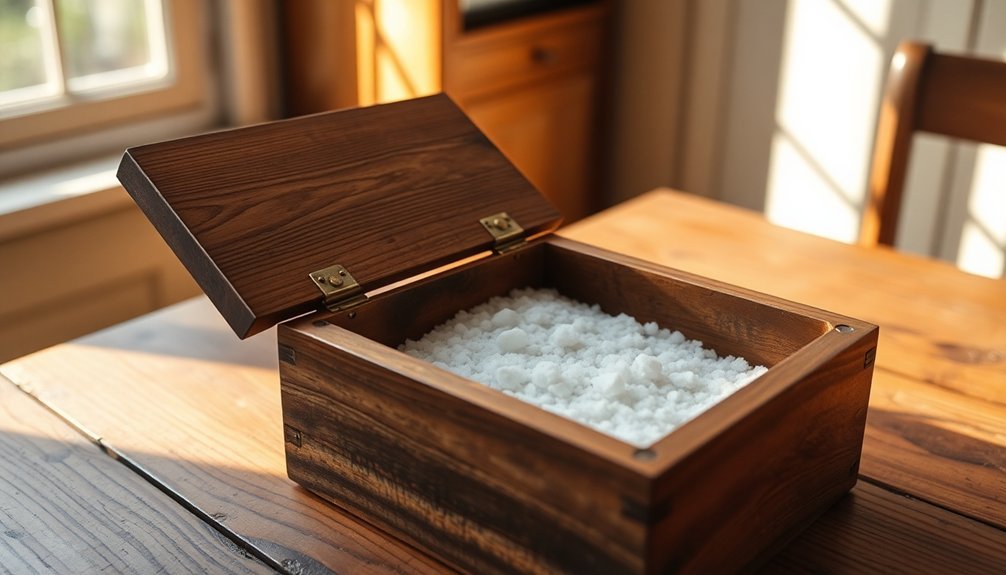
Salt boxes are indispensable kitchen tools that serve as convenient storage solutions for your cooking essentials. These practical containers allow you to store salt and other seasonings within arm's reach of your stove, making it easier to control flavoring while you cook.
You'll find that having a salt box nearby helps you grab precise pinches of salt, which leads to better-seasoned dishes and a more efficient cooking process.
When you're looking at salt boxes, you'll notice they come in various designs and materials. You can choose from wooden options like bamboo, olivewood, or acacia, each featuring protective lids that keep your seasonings fresh and contamination-free. Many salt boxes showcase a beautiful design with continuous grain patterns running across their surfaces.
Some models offer single chambers, while others provide dual compartments, giving you the flexibility to store multiple seasonings. The construction often includes mitered corners and stopped dadoes for durability, while many feature pivot lids mounted on brass rods for smooth operation.
You'll appreciate how salt boxes keep your seasonings dry by minimizing airflow, making them perfect for storing gourmet salts that won't fit in traditional shakers.
They're especially useful during cooking sessions when you need quick, one-handed access to your favorite seasonings.
Essential Materials for Salt Storage
When choosing materials for your salt storage facility, you'll need to weigh the benefits of natural options like wood against synthetic alternatives such as fabric and steel structures.
Environmental factors make proper material selection critical, as pure salt lasts indefinitely when stored under the right conditions.
Your choice should factor in durability requirements, with steel offering superior longevity despite higher maintenance needs, while fabric structures provide excellent ventilation with minimal upkeep.
The storage container must maintain airtight properties to protect against moisture infiltration, which you can achieve through proper waterproofing and stem wall construction regardless of the material selected.
Natural Vs Synthetic Options
Choosing the right storage container for salt makes all the difference between preserving its quality and risking contamination. When selecting your storage options, you'll find that natural materials consistently outperform synthetic alternatives for both safety and longevity.
Glass containers and ceramic vessels are your best choices, as they're non-reactive and won't leach chemicals into your salt. They provide excellent airtight sealing and allow you to easily monitor your salt's condition. Mason jars offer similar benefits and work well for daily use. For maximum preservation benefits, these containers help maintain salt's ability to serve as a natural food preservative.
While high-quality food-grade plastic containers are acceptable, especially for bulk storage, you'll want to verify they're specifically rated for food preservation.
Stay away from metal containers, as they'll corrode and contaminate your salt with rust particles. Don't use cardboard boxes, which attract moisture and cause clumping. Low-quality plastic containers can leach harmful chemicals, while resealable bags aren't reliable for long-term storage.
If you're using plastic containers, they should always be food-grade and preferably paired with Mylar bags for extra protection. Remember, your storage choice directly impacts your salt's usability and safety over time.
Durability of Storage Materials
Durability stands as the cornerstone of effective salt storage solutions. When you're choosing materials for your salt box, aluminum emerges as a top choice due to its exceptional rust resistance, even in challenging conditions with moisture and salt exposure.
You'll find that recyclable plastics offer similar protection while maintaining environmental responsibility.
You'll need to verify your storage structure can withstand harsh weather conditions. Consider implementing a mobile sliding roof or retractable aluminum covering to protect your salt from humidity.
Double-walled containers, like SOS storage bins, provide enhanced protection against severe weather elements. To maintain structural integrity, use 2×4 framing with 2×6 floor joists and incorporate double top plate framing.
For ideal environmental protection, you'll want to select materials that minimize replacement frequency while preventing salt leakage into surrounding soil and water.
Concrete Legioblocks combined with aluminum roofing create a robust, eco-conscious storage solution. Remember to maintain proper ventilation in your storage area to prevent moisture accumulation, and verify your structure's completely sealed during adverse weather conditions using aluminum gates.
Airtight Container Properties
Properly sealed containers play an essential role in preserving salt's quality and preventing contamination.
You'll want to choose glass containers over metal ones since salt's corrosive properties can lead to rust and contamination. When selecting your storage solution, make sure it provides complete protection against moisture, air, and unwanted odors.
To maintain your salt's best condition, you'll need to implement these critical storage practices:
- Keep your salt containers in a cool, dry place away from cooking areas to prevent exposure to steam and strong odors.
- Use waterproof covers or pads as additional protection against moisture.
- Select containers with secure locking mechanisms for easy access while maintaining an airtight seal.
Your storage solution should prioritize accessibility, especially when dealing with larger quantities.
If you're storing commercial amounts, consider containers that accommodate forklift handling and can be nested for space efficiency.
Remember that proper sealing isn't just about keeping moisture out – it's also about preserving the salt's natural flavor by preventing exposure to external odors and environmental factors that could compromise its quality.
Choosing Your Salt Box

The right salt box can make a significant difference in preserving your salt's quality and accessibility. When selecting your container, you'll need to reflect on both material and design features that align with your specific needs.
For daily kitchen use, think about glass or ceramic containers with airtight seals. Glass options can increase your salt's perceived value by 20% while providing a clear view of the contents. If you're environmentally conscious, bamboo containers offer both style and sustainability.
For long-term storage, food-grade plastic or polyethylene containers provide excellent moisture protection and prevent clumping, especially for specialty salts like Himalayan pink.
Your choice should also factor in capacity and usage patterns. If you're looking for convenient daily access, opt for salt cellars or shakers that balance protection with ease of use. For bulk storage, ponder food-grade buckets or Mylar bags.
You can maintain a practical system by using Mason jars as refill stations for your everyday shakers.
Don't forget to check the container's sealing mechanism – it's vital for maintaining salt quality. Clear containers can be particularly useful, as they'll help you monitor your salt levels and know when it's time to refill.
Proper Salt Box Placement
When you're setting up your salt box in the kitchen, you'll want to position it close to your stove for easy access while cooking.
Your chosen spot should be away from direct heat sources and moisture-prone areas to maintain the salt's quality.
For ideal functionality, place your salt box on a dry, clean counter space within arm's reach of your primary cooking area.
Kitchen Counter Positioning
Strategic placement of your salt box can greatly impact your cooking efficiency. You'll want to position it within arm's reach of your primary cooking area, typically near the stove, where you'll be doing most of your seasoning. This placement guarantees you won't have to step away from your cooking station, reducing the risk of burning food or missing vital timing in your recipes.
When deciding on the perfect counter spot, consider these essential factors:
- Keep it at least 6-8 inches from direct heat sources to prevent moisture absorption.
- Position it on the dominant hand side of your cooking space.
- Confirm it's easily accessible but won't interfere with other cooking activities.
Your salt box's location should complement your kitchen's workflow while maximizing counter space efficiency.
If you're working with limited space, opt for a compact design that won't crowd your work area.
Remember that proper positioning isn't just about convenience—it's about creating an ergonomic cooking environment that helps you maintain consistent seasoning in your dishes and supports a smooth cooking process.
Moisture-Free Zones Essential
Beyond strategic counter positioning, proper storage conditions make all the difference in maintaining your salt's quality and usability.
You'll need to make certain your salt box stays in a moisture-free zone, away from areas where cooking steam, dishwashing, or general kitchen humidity can affect it.
Choose a spot that's well-ventilated and consistently dry. Don't place your salt box near the stove, sink, or dishwasher, as these are primary sources of moisture.
If you're using a countertop salt box, make sure it has an airtight seal to protect against humidity. You'll want to use glass, food-grade plastic, or ceramic containers rather than metal ones, as salt's corrosive properties can damage metal containers over time.
Keep your salt box away from areas where you store or prepare strong-smelling foods like garlic or fish, as salt can absorb these odors.
If you're dealing with a larger storage container, add a silica packet or uncooked rice to absorb any excess moisture.
For iodized salt, it's important to keep the container in a dark spot, as sunlight can degrade the iodine content.
Salt Box Maintenance Tips
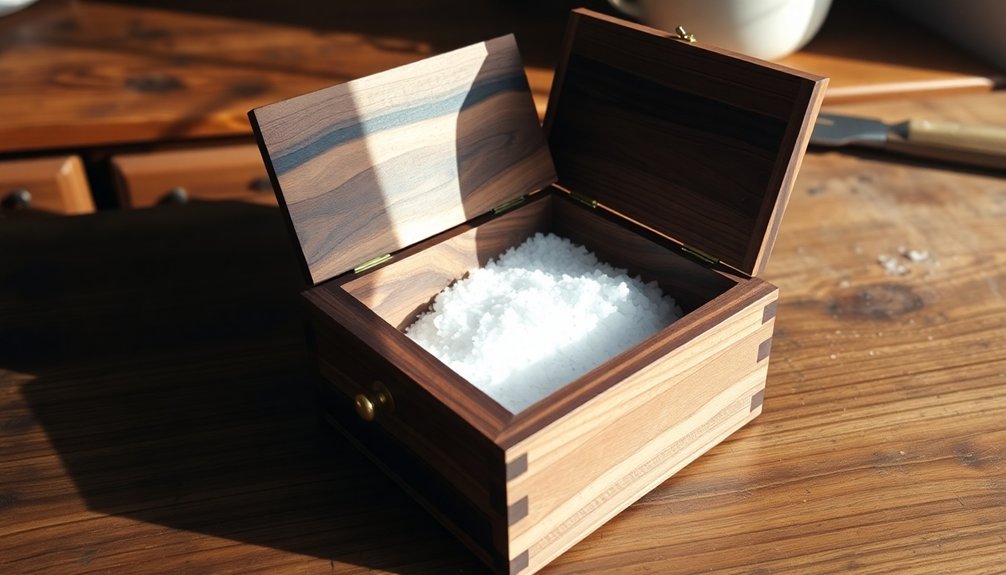
For ideal salt storage, proper maintenance of your salt box requires attention to several key factors. You'll need to regularly inspect your container for cleanliness and guarantee it remains free from moisture and contamination.
Choose an airtight container made of glass or food-grade materials, avoiding metal options that can corrode when in contact with salt.
To maintain your salt box effectively, follow these essential steps:
- Clean your container thoroughly before refilling, making certain it's completely dry to prevent clumping.
- Check periodically for signs of moisture or contamination, especially if stored in areas prone to humidity.
- Replace the moisture-absorbing rice in your salt containers every few months.
Your salt box's location plays a vital role in maintenance. Keep it away from cooking areas where steam and splashes are common, and avoid placing it near strong-smelling ingredients like garlic or fish.
If you notice any clumping or unusual odors, transfer your salt to a clean, dry container immediately. For best results, store your salt box in a cool, dark place with stable temperature conditions, and always use dry utensils when scooping salt to prevent moisture introduction.
Beyond Kitchen Salt Storage
Salt boxes offer countless organizational possibilities beyond their traditional kitchen role. You'll find these versatile containers perfect for organizing everything from office supplies to craft materials.
Whether you're storing paperclips, push pins, or rubber bands, salt boxes with magnetic swivel lids keep your desk essentials neatly contained and easily accessible.
In your home office, olive wood salt boxes provide both functionality and eco-friendly appeal, while helping you maintain a clutter-free workspace. You can repurpose them to store jewelry, small toys, or game pieces in other rooms.
For crafting enthusiasts, they're ideal for organizing beads, buttons, and other small materials.
If you're planning a dessert station, salt boxes transform into elegant serving containers for sundae toppings. Choose acacia or bamboo divided boxes to display sprinkles, nuts, and chocolate chips.
The built-in spoons make serving simple and mess-free.
You'll appreciate how salt boxes come in various materials and styles to match your decor. Whether you select single, dual, or triple compartments, these practical containers add both organization and aesthetic appeal to any space while keeping small items tidy and within reach.
Salt Types and Storage Methods
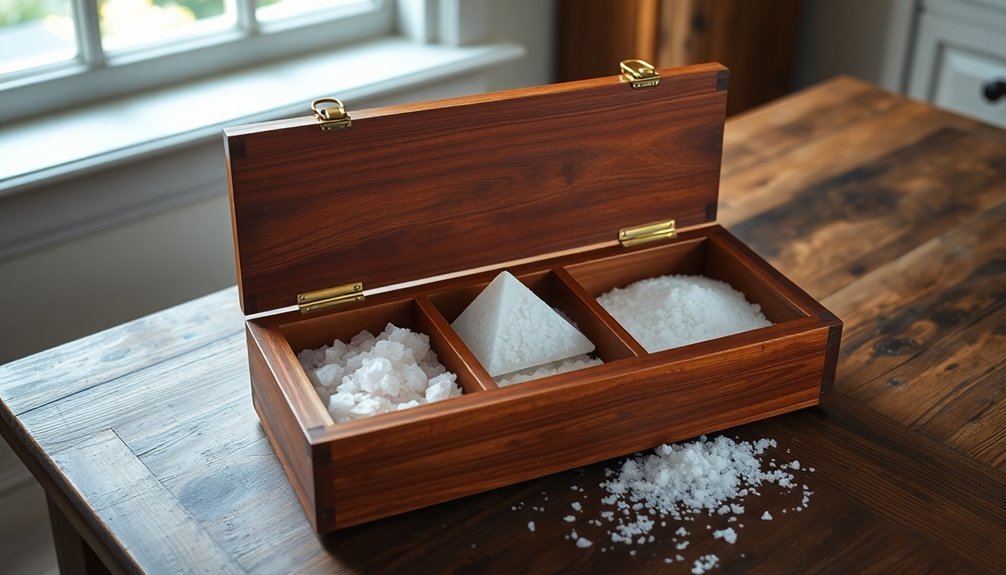
When you're selecting salt for storage, you'll want to take into account how different crystal sizes, from fine table salt to coarse kosher varieties, affect your storage needs throughout changing seasons.
Your storage methods should adapt to seasonal humidity changes, with summer months often requiring extra moisture protection like desiccant packs, while winter storage may need fewer precautions.
For ideal results, choose containers based on your salt type—glass jars work well for everyday cooking salts, while food-grade plastic buckets are better for bulk storage of canning and pickling salt.
Different Salt Crystal Types
Crystal diversity plays an essential role in how you'll use and store different types of salt. From fine table salt's uniform crystals to the pyramid-shaped flakes of Maldon, each type's structure determines its best use in cooking and storage requirements.
Fine salts, including table salt and some extracted brines, feature consistent, small crystals that make them ideal for precise measurements and even distribution. You'll find these most commonly in everyday cooking and baking, where uniform crystal size guarantees reliable results.
Here's why crystal structure matters in salt storage:
- Larger crystals, like those in kosher salt, resist clumping and moisture absorption better than fine crystals.
- Flaky salts, such as fleur de sel and Maldon, need careful storage to maintain their delicate structure.
- Rock salts, including Himalayan pink salt, typically have more stable crystals that store well long-term.
Sea salts often contain natural minerals that can affect both their crystal formation and storage needs.
You'll want to store specialty salts like fleur de sel in airtight containers to preserve their unique textures and prevent moisture from altering their distinctive crystal shapes.
Storage Methods by Season
Building on our understanding of crystal structures, proper storage methods change with the seasons to protect your salt's integrity.
During winter, you'll need to focus on keeping your salt in a cool, dry environment where temperature fluctuations are minimal. Store your salt in airtight containers and guarantee it's protected from rain and snow to prevent moisture absorption.
Summer storage requires extra attention to heat and light exposure. You'll want to keep your salt in dark, cool locations away from direct sunlight, which is particularly important for iodized salt. Use airtight containers to shield your salt from both moisture and strong odors that can affect its quality.
For year-round storage, don't use metal containers as salt's corrosive properties can damage them. Instead, opt for food-grade plastic buckets or glass jars with tight-fitting lids.
If you're in a high-humidity area, consider adding food-grade silica gel packets to your storage containers to control moisture levels.
Remember that pure salt can last indefinitely when stored properly, but it's hygroscopic nature means it'll readily absorb moisture from its environment, leading to clumping and texture changes if not protected.
Optimal Container Selection
Your salt's storage needs vary considerably based on the type you're using and how you plan to use it. For long-term storage, you'll want to focus on non-iodized varieties, as iodized salt can lose its fortification over time. Glass and ceramic containers offer the best protection, while food-grade plastic provides a practical alternative for everyday use.
When selecting your storage container, consider these critical features:
- An airtight seal to prevent moisture infiltration
- Non-reactive material that won't corrode from salt contact
- Easy accessibility for your intended use frequency
For daily cooking, you'll find salt cellars or shakers convenient, but they should be kept away from the stove where heat and moisture can affect the salt's quality.
If you're storing larger quantities, consider using food-grade buckets or mylar bags, but don't add oxygen absorbers as they're unnecessary and can cause clumping.
While metal containers might seem sturdy, they're not suitable for salt storage due to corrosion risks.
Remember that different salt types may require different storage approaches – rock salt and kosher salt's larger crystals make them less prone to clumping, while finer table salt needs extra protection from moisture.
Long Term Storage Solutions
Long-term storage solutions come down to choosing the right containers and maintaining proper conditions. For ideal salt preservation, you'll want to focus on Mylar bags and food-grade buckets, which provide excellent protection against moisture, light, and air. While 2-gallon buckets are easier to handle, larger containers work well if you're storing substantial quantities.
You'll need to place your storage containers in a cool, dry, and dark location. Your basement or root cellar can be ideal spots, as they typically maintain stable temperatures. Don't store your salt in outdoor buildings like sheds or garages, where temperature fluctuations can affect quality. Instead, consider using pantry shelves in a cooler part of your house.
To maintain your salt's quality over time, you'll want to implement a rotation system, especially for iodized salt which can lose its effectiveness. Keep track of your inventory and regularly check for any signs of moisture or contamination.
If you're using Mylar bags, verify they're properly sealed, and when using buckets, verify that the lids are airtight to prevent moisture from compromising your salt's long-term viability.
Preventing Moisture and Contamination
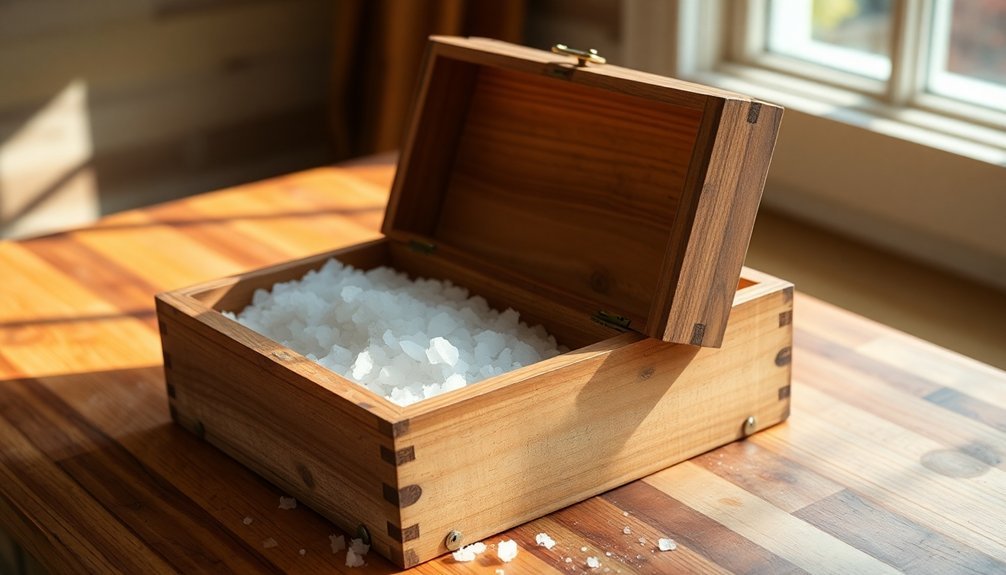
Moisture poses the greatest threat to your salt's longevity in storage. You'll need to employ multiple strategies to keep your salt dry and pristine. Using desiccants like silica gel or calcium chloride will help absorb excess moisture from the air, while maintaining proper storage temperatures between 32-40°F (0-4°C) creates ideal conditions for preservation.
To effectively protect your salt, you'll want to focus on these critical moisture control methods:
- Install desiccant-filled poles on container walls or place desiccant bags on the floor, replacing them when depleted.
- Use humidity control devices like Boveda packs that maintain specific relative humidity levels.
- Keep containers tightly sealed with additional barriers like plastic wrap or rubber gaskets.
Don't overlook contamination prevention while focusing on moisture control. Use only clean, sanitized equipment and food-grade storage containers.
Choose coarse-grained salt like kosher or sea salt for better preservation results, and avoid varieties with additives. Store your salt away from potential contaminants such as chemicals, pests, or strong odors, and regularly inspect your storage area for any signs of moisture buildup or infestation.
Traditional Salt Box Features
Salt boxes were named for their distinctive sloped roofline that resembles colonial-era wooden boxes used to store salt. You'll notice these homes feature a two-story front facade and a long, sloping roof that swoops down to a single story in the back, creating their signature profile. The exterior showcases symmetrical front windows, horizontal clapboard siding, and a prominent central chimney.
| Feature | Description |
|---|---|
| Entrance | Central front door with transom above |
| Windows | Six-over-six pane sash, symmetrically placed |
| Roofline | Asymmetrical gable with steep front, gradual rear slope |
| Construction | Post and beam frame with brick pier foundation |
When you step inside, you'll find a spacious great room that serves as the living area, featuring exposed ceiling beams and thick-cut wood planks for flooring. The heart of these homes centers around a large brick or stone fireplace with a central chimney that extends through both stories. You'll find the kitchen positioned at the rear of the house, often within the lean-to addition, making efficient use of the sloped roofline's lower section.
Benefits of Salt Box Storage
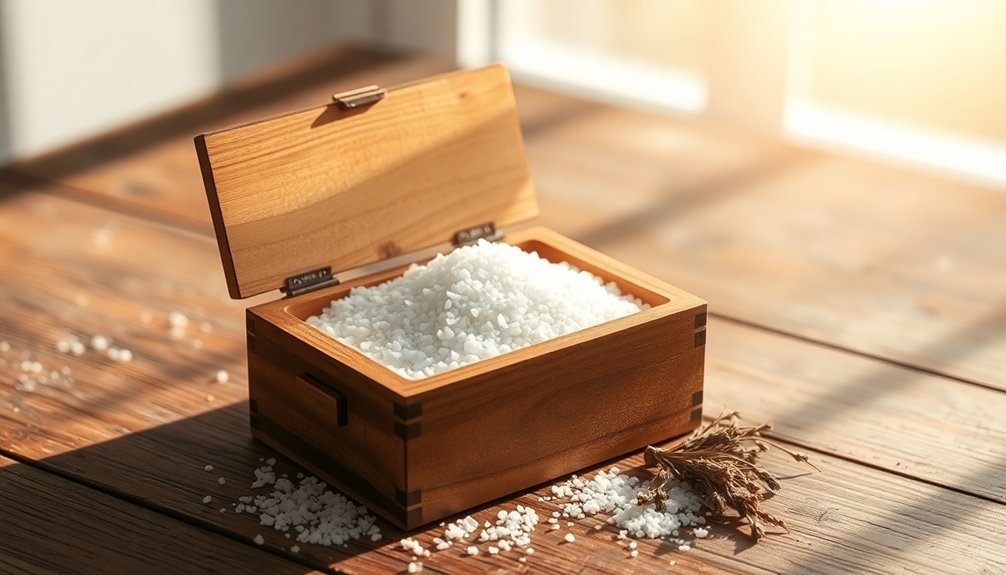
Numerous benefits make salt box storage an essential preservation method in both traditional and modern kitchens.
You'll find that salt boxes provide excellent protection from moisture while offering easy access during cooking. By keeping your salt and other seasonings in these containers, you're ensuring they stay dry and ready to use, which is vital for both preservation and culinary purposes.
When you use a salt box for storage, you'll gain several practical advantages for food preservation and cooking:
- Moisture control: The box creates an ideal environment that prevents clumping and maintains the salt's effectiveness in food preservation.
- Convenient access: You can easily reach for precise amounts while cooking, improving your control over seasoning.
- Versatile storage: You're able to store different types of salt and seasonings in compartmentalized boxes.
The health and safety benefits are equally important. You're protecting your seasonings from contamination while maintaining their preservation properties.
For those who use specialty salts, salt boxes offer the perfect storage solution to maintain the unique qualities of flaked or coarse varieties.
Additionally, you'll find that proper storage helps maintain the nutritional value of salt-cured foods over extended periods.
Salt Box Design Elements
Understanding the unique design elements of salt boxes reveals a remarkable blend of form and function. You'll notice the distinctive asymmetrical roofline, featuring a steeper pitch (9/12 to 12/12) in the rear section and a gentler slope (4/12 to 6/12) in the front. This design creates extra headroom in the back while maintaining structural integrity.
The construction relies on robust 2×4 and 2×6 trusses, with walls framed using 2x4s placed 16 inches on center. You'll find a double top plate that adds stability to the structure.
The flooring system incorporates 2×6 joists topped with 3/4-inch sheathing, providing a solid foundation for your storage needs.
You can customize your salt box with various materials. The exterior can feature T1-11 siding, wood, metal, or vinyl, while the roof accommodates traditional wood shakes, shingles, or modern metal and composite materials.
You're able to enhance the structure with windows, custom-sized doors built with sandwich construction, and even add dormers or lofts for additional space and visual appeal.
Everyday Salt Box Uses
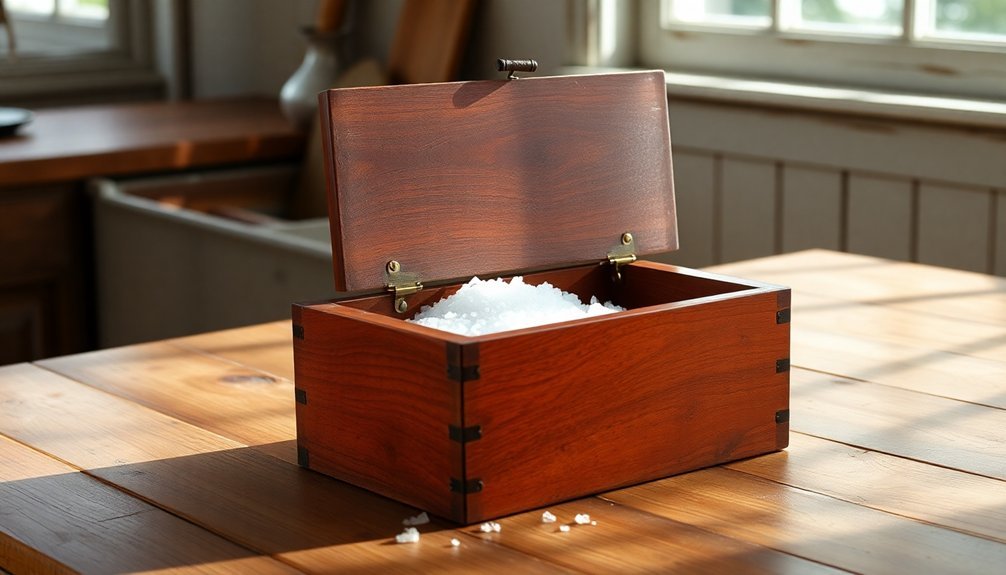
Modern salt boxes serve four essential purposes in today's homes, making them indispensable tools for both cooking and storage. In the kitchen, you'll find them invaluable for precise seasoning control, allowing you to grab the perfect pinch of salt with one hand while cooking. They're especially suited for specialty salts that won't work in traditional shakers, such as flaked varieties and kosher salt.
Beyond salt storage, these versatile containers can revolutionize your cooking workflow in several ways:
- Store frequently used spice combinations for specific dishes
- Keep baking ingredients like sugar and specialty sweeteners within easy reach
- Organize complementary herbs and seasonings for quick access
You'll discover that salt boxes aren't limited to kitchen duties. They're perfect for organizing small items throughout your home, from office supplies to jewelry. Their durable construction in materials like bamboo and olivewood makes them suitable for various storage needs.
For entertaining, you can repurpose them as part of a dessert station, holding ice cream toppings or condiments. With features like magnetic lids and swivel covers, they're practical solutions for both traditional and modern storage needs.
Frequently Asked Questions
Can Salt Boxes Be Used in High-Humidity Environments Like Bathrooms?
You shouldn't store salt boxes in bathrooms due to high humidity. The moisture will cause your salt to clump and absorb unwanted odors. It's best to keep them in cool, dry spaces instead.
Do Electromagnetic Fields From Induction Cooktops Affect Salt Stored Nearby?
You don't need to worry about your salt being affected by induction cooktop EMFs. The electromagnetic fields decrease rapidly with distance and don't greatly impact non-conductive materials like salt stored in nearby containers.
How Often Should Wooden Salt Boxes Be Treated With Mineral Oil?
You'll need to treat your wooden salt box monthly if it's heavily used, or every few months if used less frequently. Monitor the wood's condition and apply mineral oil when the surface appears dry or faded.
Can Salt Boxes Be Safely Cleaned in a Dishwasher?
No, you shouldn't put salt boxes in the dishwasher. If yours is wooden, bamboo, or marble, you'll need to hand wash it. Only glass and porcelain salt boxes are dishwasher-safe.
Are There Special Considerations for Storing Black Salt in Wooden Boxes?
You'll need an extra-dry environment for black salt since it's more moisture-sensitive. Choose dense hardwoods like oak or walnut, and line your box with natural wax to protect against the salt's sulfuric compounds.
In Summary
You've discovered one of the most reliable and time-tested methods of food preservation. Whether you're using a traditional wooden box or a modern ceramic version, your salt box will serve as a faithful kitchen companion. Keep it clean, dry, and properly positioned, and you'll enjoy the benefits of this natural storage solution for years to come. It's a practical investment that connects you to centuries of culinary wisdom.

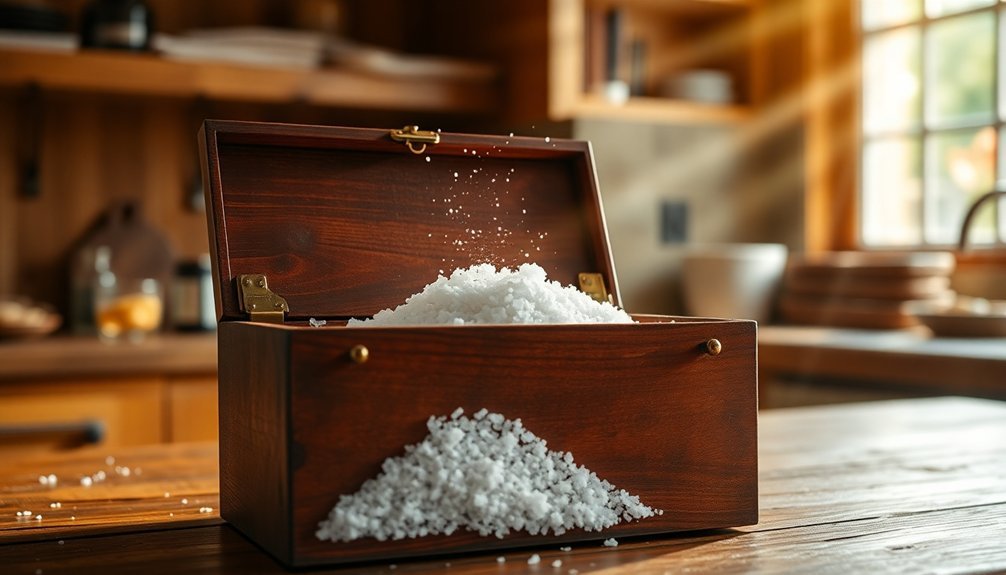



Leave a Reply